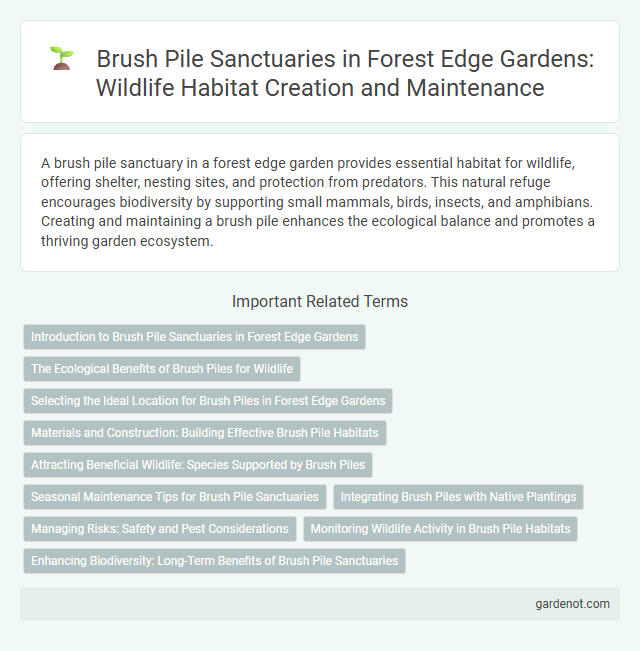A brush pile sanctuary in a forest edge garden provides essential habitat for wildlife, offering shelter, nesting sites, and protection from predators. This natural refuge encourages biodiversity by supporting small mammals, birds, insects, and amphibians. Creating and maintaining a brush pile enhances the ecological balance and promotes a thriving garden ecosystem.
Introduction to Brush Pile Sanctuaries in Forest Edge Gardens
Brush pile sanctuaries in forest edge gardens create vital habitats by providing shelter and nesting sites for a variety of wildlife, including birds, small mammals, and beneficial insects. These natural refuges enhance biodiversity by offering protection from predators and harsh weather while promoting ecosystem health through organic matter decomposition. Strategically positioned along garden edges, brush piles contribute to soil enrichment and serve as essential components of sustainable garden management.
The Ecological Benefits of Brush Piles for Wildlife
Brush piles in forest edge gardens create vital habitats by providing shelter and nesting sites for diverse wildlife species, including birds, small mammals, and insects. These structures enhance biodiversity by offering protection from predators and harsh weather, supporting ecosystem stability and resilience. Decomposing organic material within brush piles enriches soil fertility, promoting plant growth and contributing to a balanced forest edge ecosystem.
Selecting the Ideal Location for Brush Piles in Forest Edge Gardens
Selecting the ideal location for brush piles in forest edge gardens involves prioritizing areas with natural cover and proximity to wildlife corridors to maximize habitat benefits. Positioning brush piles near the garden's perimeter enhances shelter for small mammals, birds, and beneficial insects, promoting biodiversity. Avoid placing piles too close to structures or pathways to reduce fire hazards and maintain accessibility.
Materials and Construction: Building Effective Brush Pile Habitats
Brush pile sanctuaries are constructed using a combination of native hardwood branches, logs, and brush arranged in a loose, layered structure to create dense cover and nesting sites for wildlife. Selecting materials such as fallen tree limbs, small logs, and thorny branches enhances habitat complexity and provides protection from predators. Strategically positioning the pile in shaded, moist areas near forest edges increases its attractiveness to birds, small mammals, and beneficial insects, supporting biodiversity in the garden ecosystem.
Attracting Beneficial Wildlife: Species Supported by Brush Piles
Brush pile sanctuaries in forest edge gardens support a diverse range of beneficial wildlife, including amphibians, small mammals, and songbirds. These structures provide critical shelter, nesting sites, and foraging opportunities, enhancing local biodiversity. Species such as box turtles, chipmunks, and wrens rely on brush piles for protection and food resources, contributing to natural pest control and ecosystem health.
Seasonal Maintenance Tips for Brush Pile Sanctuaries
Seasonal maintenance of brush pile sanctuaries includes removing excessive debris in early spring to prevent mold and pest infestations while preserving essential cover for wildlife. During late fall, trimming nearby vegetation improves airflow and sunlight penetration, reducing moisture buildup that can damage the structure. Regular monitoring throughout the year ensures that the brush pile remains a safe habitat for birds, small mammals, and beneficial insects.
Integrating Brush Piles with Native Plantings
Brush pile sanctuaries enhance biodiversity by providing shelter and nesting sites for birds, reptiles, and small mammals along forest edge gardens. Integrating brush piles with native plantings such as goldenrod, asters, and native grasses creates a seamless habitat that supports pollinators and wildlife while promoting natural decomposition and soil health. Strategic placement near dense native shrubs maximizes ecological benefits and encourages a balanced microhabitat.
Managing Risks: Safety and Pest Considerations
Brush pile sanctuaries in forest edge gardens require careful management to minimize safety hazards such as sharp branches, unstable structures, and potential fire risks. Properly maintaining piles by keeping them compact and located away from high-traffic areas reduces the chance of injury and helps control rodent and insect infestations. Regular monitoring for pests like ticks, snakes, and invasive insects ensures the sanctuary supports wildlife without becoming a hazard to humans.
Monitoring Wildlife Activity in Brush Pile Habitats
Brush pile sanctuaries serve as critical habitats for diverse wildlife species, providing shelter and nesting sites at the forest edge garden. Monitoring wildlife activity in these brush piles involves the use of motion-activated cameras and direct observation to track species presence, behavior, and seasonal patterns. Data collected supports habitat management decisions, enhancing biodiversity conservation and ecosystem health in forest edge environments.
Enhancing Biodiversity: Long-Term Benefits of Brush Pile Sanctuaries
Brush pile sanctuaries in forest edge gardens create critical microhabitats that support a diverse array of wildlife, including insects, amphibians, birds, and small mammals. These structures contribute to soil health by promoting decomposition and nutrient cycling, which enhances plant growth and ecological resilience. Over time, brush piles help stabilize local ecosystems, increasing biodiversity and fostering long-term environmental sustainability.
Brush pile sanctuary Infographic

 gardenot.com
gardenot.com